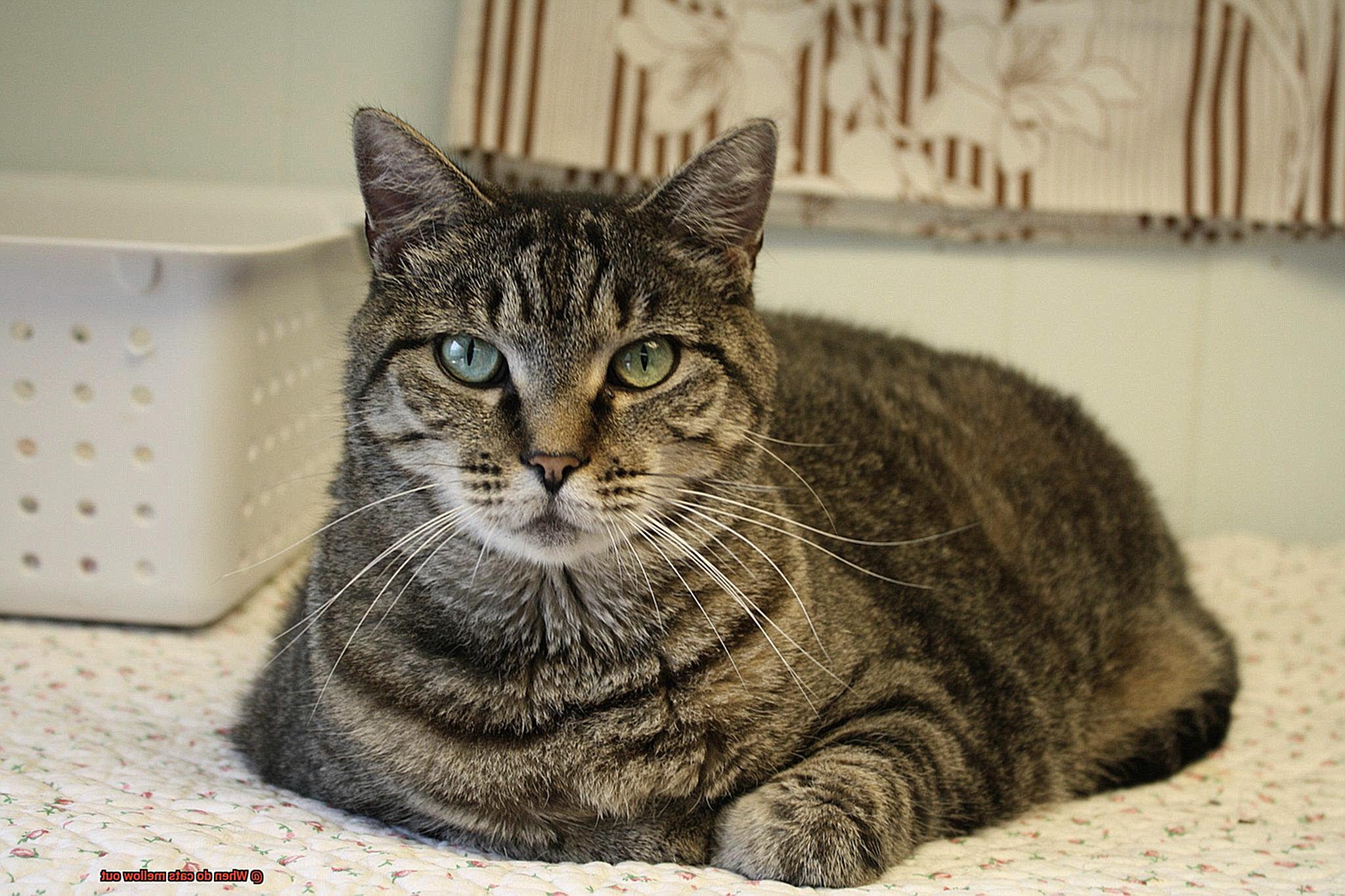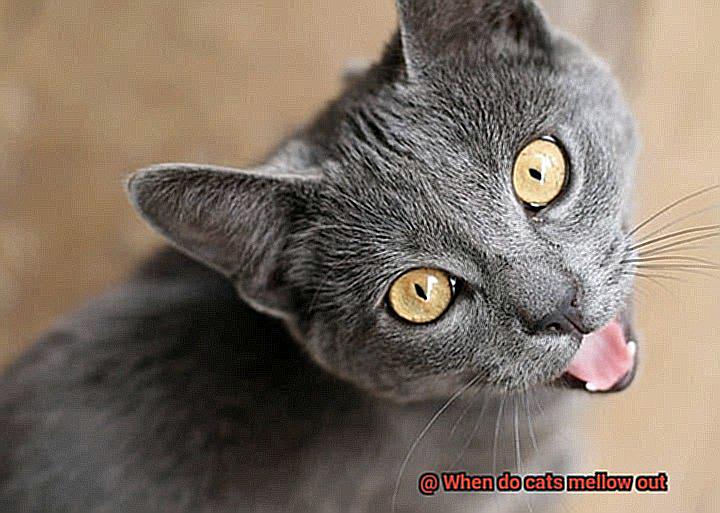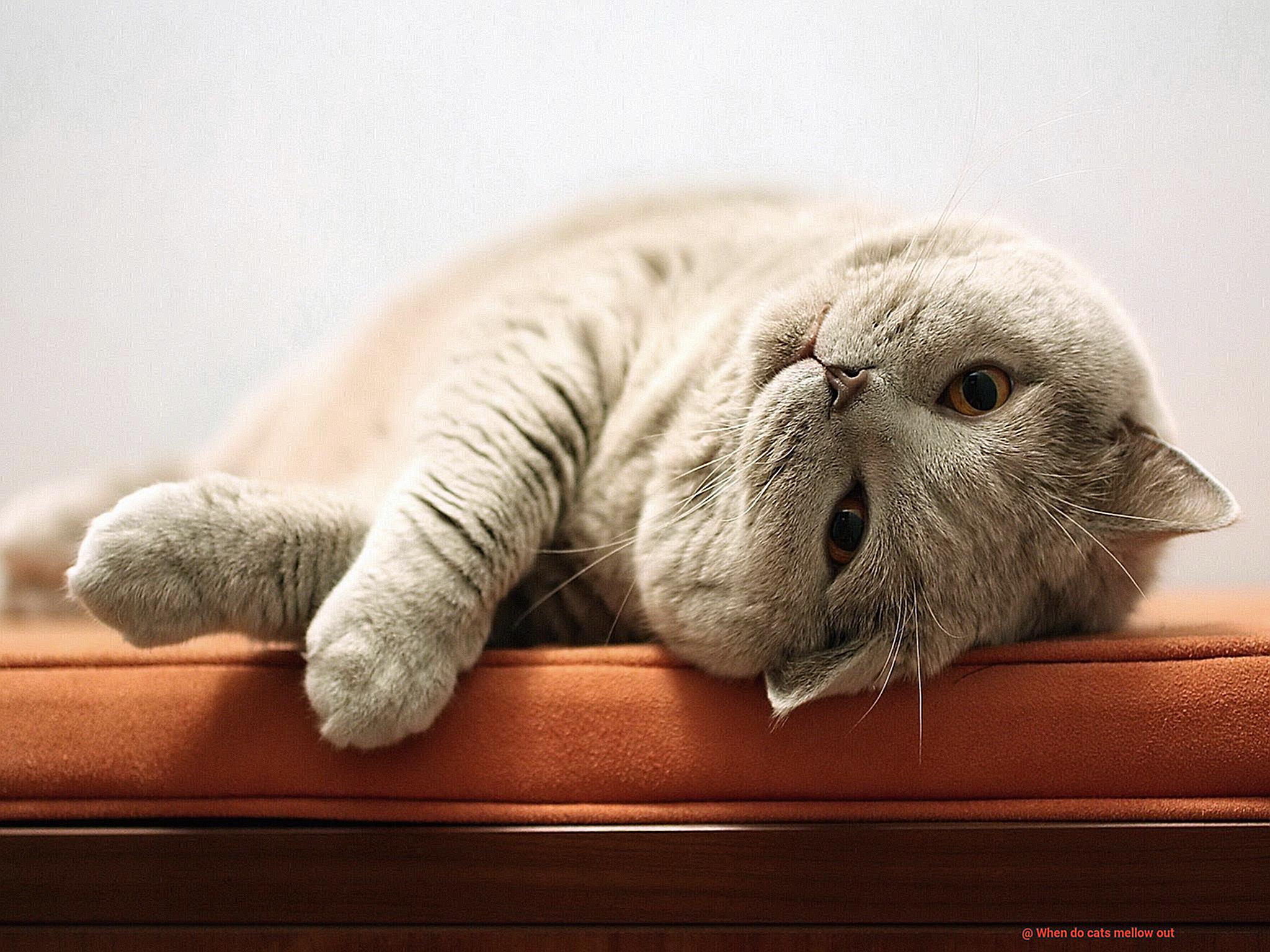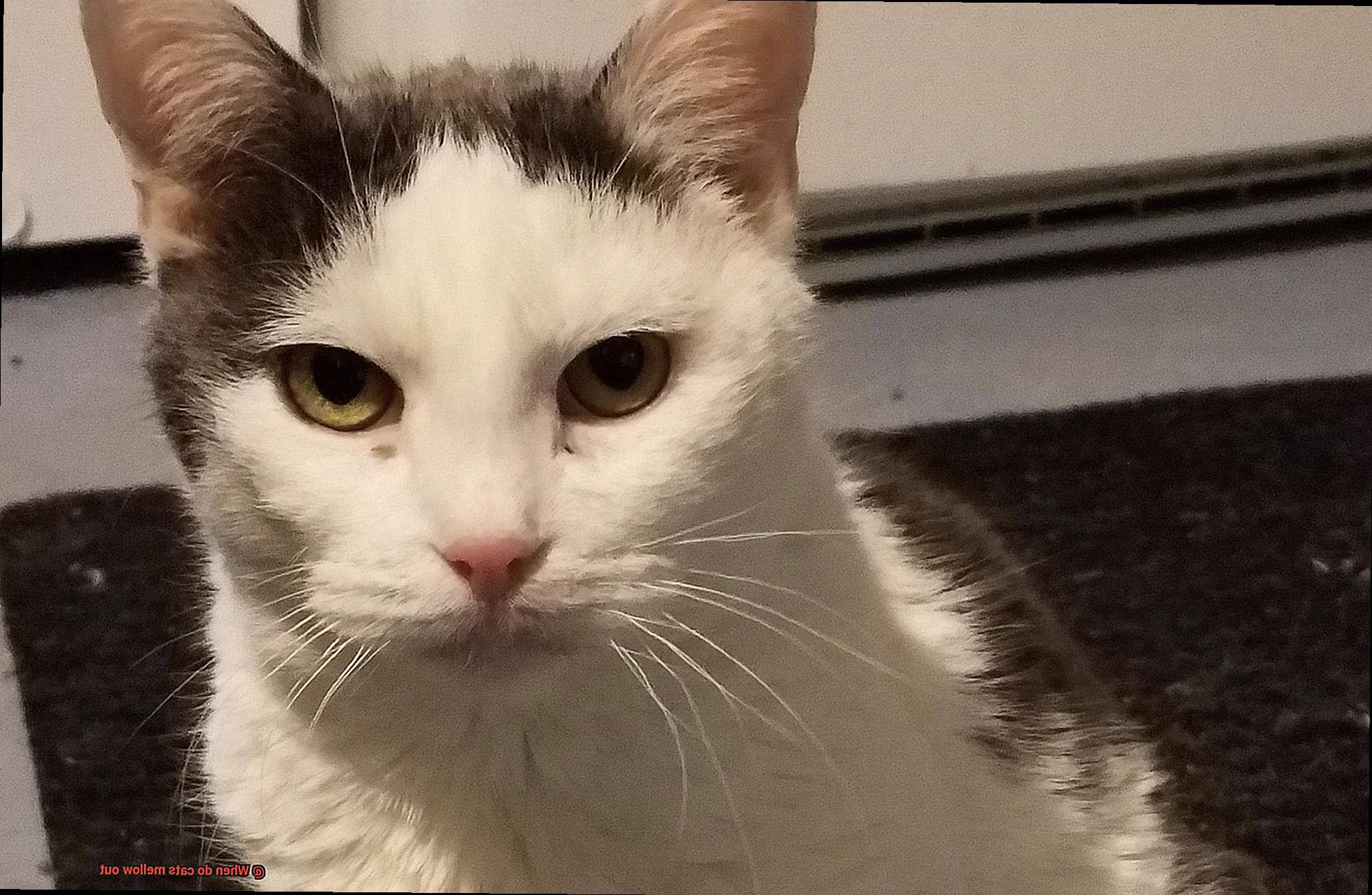Cats are truly captivating creatures. They can be aloof and mysterious one moment, and then suddenly transform into playful and mischievous felines the next. But as cats mature, they tend to undergo a metamorphosis that leads them to mellow out. So, when exactly does this happen?
As an expert in feline behavior, I’ve spent years studying these fascinating animals. Just like humans, cats go through various stages of development throughout their lives. They start off as curious and energetic kittens, but eventually evolve into more relaxed and easygoing adult cats.
The timeline for when a cat will mellow out depends on several factors such as breed, genetics, and environment. Some cats may take longer to reach this stage than others. However, there are certain signs you can look out for that indicate your furry friend is starting to chill out.
In this blog post, I’ll delve into the different stages of a cat’s life and what you can expect from your feline companion as they age. Whether you’re a first-time cat owner or have been living with these majestic creatures for years, you’ll discover valuable insights into the fascinating process of a cat’s mellowing out.
So, let’s get started.

What is the Typical Age Range for Cats to Mellow Out?
However, there are some general guidelines that can give you an idea of what to expect.
Most cats go through different stages of development as they grow older. While kittens are known for their endless energy and curiosity, they tend to become more independent and less active as they reach adulthood (around 1-2 years old). However, some cats may continue to be playful well into their adult years, while others may become more sedentary at an earlier age. It all depends on factors such as breed, health, diet, environment, and personality.
In general, older cats tend to be more mellow and laid-back than younger cats. By middle age (around 7-10 years old), most cats have slowed down and become less active. They may also develop health issues such as arthritis, which can affect their mobility and comfort. But keep in mind that the process of a cat mellowing out is gradual and varies from one cat to another.
Breed is also a factor in a cat’s activity level and behavior. For example, Siamese cats are known for being energetic and playful well into their senior years, while Persian cats tend to be more relaxed and may start to mellow out as early as two years old.
The environment in which a cat lives can also make a big difference in their behavior. If a cat is living in a stressful or chaotic household, they may take longer to relax and become more calm. Conversely, if a cat is living in a calm and peaceful home with attentive owners, they may mellow out faster.

As a responsible cat parent, you can help your pet mellow out by providing them with the care and attention they need. This includes a suitable diet, plenty of fresh water, regular exercise and playtime, comfortable resting areas, and a clean litter box. And don’t forget to give your furry friend plenty of love and attention.
What Factors Determine When a Cat Will Mellow Out?
While it’s not always easy to predict, there are several factors that can impact when a cat will mellow out.
Firstly, it’s important to remember that every cat is unique, with their own personality and temperament. Some cats may be more laid back naturally, while others may be more high-strung and easily stressed.
One of the most significant factors that can impact a cat’s mellowing process is their age. As kittens, cats are full of energy and curiosity. However, as they get older, they tend to become more calm and relaxed. This is because they are still developing physically and mentally, and as they mature, they become more confident and comfortable in their surroundings.
Another crucial factor that can influence a cat’s temperament is their environment. If a cat lives in a noisy or chaotic home, they may be more prone to anxiety and stress. Conversely, if a cat lives in a calm and quiet environment where they feel safe and secure, they are more likely to be relaxed and mellow.
The breed of the cat can also play a role in how quickly they mellow out. Certain breeds such as Maine Coon or British Shorthair are known for being particularly laid back and easygoing, while other breeds like Siamese or Bengal may be more high-strung and energetic.
In conclusion, understanding the various factors that can impact when a cat will mellow out can help you provide your feline friend with the proper care and attention they need to feel relaxed and content in their home. By providing them with a safe and comfortable environment, you can help them mellow out faster and enjoy their golden years with ease.
How Can Cat Owners Help Their Cats Mellow Out?
One of the easiest and most effective ways to help your cat destress is through playtime. Regular play sessions with your cat can provide them with the necessary exercise and stimulation they need to burn off excess energy and reduce stress levels. So, make sure to set aside some time each day for interactive play with your furry friend.
Creating a peaceful environment for your cat is also crucial. This includes providing them with a cozy and comfortable place to sleep, as well as minimizing loud noises and other stressors in their environment. Additionally, incorporating calming scents such as lavender or chamomile can also help to create a relaxing atmosphere for your cat.
Interactive toys or puzzle feeders are another great way to help your cat mellow out. These types of toys can keep your cat mentally stimulated and engaged, reducing boredom and preventing destructive behavior that may be caused by stress or anxiety.
But it’s not just about what you provide for your cat; it’s also about how you behave around them. Cats are sensitive creatures and can pick up on their owner’s stress levels. Therefore, it’s essential to maintain a calm and relaxed demeanor around them. Positive reinforcement training techniques can also be used to teach cats new behaviors or reward them for good behavior, which can ultimately help them mellow out.
In conclusion, there are many ways cat owners can help their furry friends mellow out, from playtime to creating a peaceful environment and using interactive toys. By understanding their cat’s behavior and needs, cat owners can provide a safe and comfortable home for their feline friends to relax and unwind.
Common Behaviors of Older, More Relaxed Cats
Just like humans, cats also go through changes in their behavior as they age. Here are some insights that will help you better understand your furry friend:
Firstly, it’s no secret that older cats love to sleep. They may spend up to 20 hours a day snoozing. Their bodies are slowing down, and they need more rest than their younger counterparts. So, don’t worry if you find your senior cat dozing off most of the day; it’s just a part of their natural rhythm.
Secondly, while older cats may not be as active or energetic as they used to be, they can still enjoy a good game of chase or batting around a toy. However, their pace is slower now, so make sure to provide them with toys that cater to their needs.
Thirdly, older cats tend to be more affectionate than younger cats. They love spending time with their owners and will seek out attention and cuddles more often. So, take advantage of these precious moments and shower your furry friend with some extra love.
Fourthly, an interesting fact about older cats is that they may have quieter meows than when they were younger. Their vocal cords may have weakened over time, but they still find other ways to communicate with their body language and other cues. So, pay close attention to your cat’s signals to understand what they need.
Lastly, grooming is an important part of a cat’s life. Older cats spend more time grooming themselves than younger ones because they may have trouble reaching certain spots on their bodies. They need to spend more time keeping themselves clean.
Overall, older cats that have mellowed out tend to be calmer and more relaxed than their younger counterparts. As a cat owner, it’s important to understand these changes in behavior so you can provide the best care for your furry friend as they age.
Tips for Creating a Comfortable Environment for Your Cat
Creating a comfortable environment for your cat is crucial to helping them mellow out and feel relaxed in their home. Here are five tips to consider:

Provide a Cozy Bed
Cats love to sleep, and having a comfortable bed is essential for their overall well-being. A cozy bed should be soft, warm, and located in a quiet area of your home. Make sure it’s big enough for your cat to stretch out and move around comfortably. You can invest in a high-quality cat bed or create a comfortable spot with soft blankets and pillows.
Keep the Litter Box Clean

A dirty litter box can cause stress and anxiety for your cat, so it’s essential to keep it clean. Scoop it daily and replace the litter every week. A clean litter box will not only make your cat happy but also benefit their health.
Offer Plenty of Scratching Posts
Scratching is a natural behavior for cats, and providing them with designated scratching posts can prevent them from scratching your furniture. Make sure the posts are sturdy and tall enough for your cat to fully stretch out. Scratching posts will help keep your cat’s claws healthy, relieve stress, and satisfy their natural instincts.
Create Playtime

Engaging your cat in playtime is essential for their physical and mental health. Playing with your cat can help them release pent-up energy, reduce stress, and strengthen the bond between you two. Offer toys that stimulate their hunting instincts, such as feather wands or laser pointers.
Give Them Space
Cats are independent creatures that need their space to feel comfortable. Make sure they have access to quiet areas where they can retreat if they need some alone time. Providing hiding spots like boxes or baskets around the house can make them feel safe and secure.
In conclusion, creating a comfortable environment for your cat is essential for their overall well-being, and it can also help them mellow out. Remember that every cat is unique, so be patient and observant with your pet’s needs.
The Process of a Cat Mellowing Out is Gradual
It takes time for cats to become more relaxed and comfortable in their environment, and various factors can play a role in how quickly or slowly they do so.
Age is one of these factors. Young kittens who have been socialized from an early age may mellow out more quickly than older cats who have had limited socialization experiences. Kittens are more adaptable and open to new experiences, while older cats may be set in their ways.
Temperament is another factor that can affect the rate at which a cat mellows out. Cats with a more laid-back personality may be more prone to relaxing and becoming comfortable in their surroundings than more high-strung cats. However, every cat is unique, and this is not always the case.
Past experiences can also impact how quickly or slowly a cat mellows out. If your cat has had negative experiences in the past, such as being mistreated or living in a stressful environment, it may take them longer to feel safe and comfortable in their new home.
As a pet owner, there are things you can do to help facilitate the process of your cat mellowing out. Providing plenty of opportunities for play and exercise can help release any pent-up energy and promote feelings of relaxation. Creating a comfortable and safe environment for your cat to relax in can also help them feel calm and at ease.
It’s important to remember that while the process of a cat mellowing out may take time, patience and understanding from the pet owner is crucial. With love, patience, and positive reinforcement, most cats will eventually become comfortable and content in their home.
7q2xI4TPGeU” >
Conclusion
To sum it up, cats are truly fascinating creatures that undergo a series of developmental stages throughout their lives. However, as they mature, they tend to become more relaxed and easygoing. The timeline for when a cat will mellow out can be influenced by several factors such as breed, genetics, and environment. But fret not. There are tell-tale signs that your feline friend is starting to chill out.
As cats age, they tend to become more laid-back and less active than their younger counterparts. By middle age (around 7-10 years old), most cats have slowed down considerably and may develop health issues like arthritis that affect their mobility and comfort.
Creating a comfortable living space for your cat is crucial in helping them mellow out and feel at ease in their home. This includes providing them with a cozy bed, keeping the litter box clean, offering plenty of scratching posts, playing with them regularly, and giving them ample space to roam around.
The process of a cat mellowing out usually takes some time and varies from one cat to another. However, with love, patience, and positive reinforcement from pet owners like you, most cats will eventually become comfortable and content in their home.







